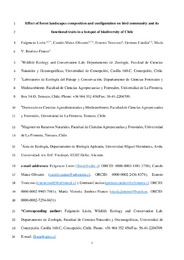Por favor, use este identificador para citar o enlazar este ítem:
https://hdl.handle.net/11000/30572
Effect of forest landscapes composition and configuration on bird community and its functional traits in a hotspot of biodiversity of Chile
Título :
Effect of forest landscapes composition and configuration on bird community and its functional traits in a hotspot of biodiversity of Chile |
Autor :
Lisón Gil, Fulgencio 
Matus Olivares, Camilo Salvador 
Troncoso Villegas, Ernesto Nicolás 
Catalán, German
Jiménez Franco, María Victoria  |
Editor :
Elsevier |
Departamento:
Departamentos de la UMH::Biología Aplicada |
Fecha de publicación:
2022-06 |
URI :
https://hdl.handle.net/11000/30572 |
Resumen :
Understanding the effect of landscape configuration on the bird species richness and their functional traits (dietary preferences) is important to link the conservation and restoration plans to the production of the crops. Our aims were: 1) to study the influence of forest types (native, mixed and plantations) on the bird species richness in two agroforestry landscapes (heterogeneous/homogeneous); 2) to assess the effect of size/density of forest patches in the birds’ functional traits; 3) to evaluate the effect of isolated trees on them, and 4) to discuss conservation and restoration measures for the birds’ functional traits in agroforestry landscapes. We used hierarchical occupancy models to evaluate the effect of different landscape metrics and detectability measures on bird communities. We recorded a total of 64 bird species. The estimated species richness was considerable higher in homogeneous landscape (31.7 ± 2.7) than heterogeneous (27.3 ± 2.5). Our results showed the bird assemblage had a positive trend with native forests, negative with mixed forests and neutral trend for plantations. The granivores and insectivore’s species showed significant preferences for homogeneous landscape, while omnivores had significant preferences for heterogeneous landscape. Carnivores/Piscivores and herbivores/frugivores species did not show preferences by any landscape type. The response of functional traits depended on different forests attributes. The isolated trees had a significant effect on the birds’ functional traits. In conclusion, it is necessary a deep knowledge about the relationship between the landscape configuration and the bird species richness/functional traits. These findings could help in the future with the conservation, restoration, and rewilding policies in this important hotspot of biodiversity, avoiding alterations in the ecosystem services.
|
Palabras clave/Materias:
Agroforestry
Bird guilds
Landscape metrics
Occupancy models
Plantations |
Área de conocimiento :
CDU: Ciencias aplicadas: Ingeniería. Tecnología |
Tipo de documento :
info:eu-repo/semantics/article |
Derechos de acceso:
info:eu-repo/semantics/openAccess
Attribution-NonCommercial-NoDerivatives 4.0 Internacional |
DOI :
https://doi.org/10.1016/j.jnc.2022.126227 |
Aparece en las colecciones:
Artículos Biología Aplicada
|
 La licencia se describe como: Atribución-NonComercial-NoDerivada 4.0 Internacional.
La licencia se describe como: Atribución-NonComercial-NoDerivada 4.0 Internacional.
 La licencia se describe como: Atribución-NonComercial-NoDerivada 4.0 Internacional.
La licencia se describe como: Atribución-NonComercial-NoDerivada 4.0 Internacional.
.png)
